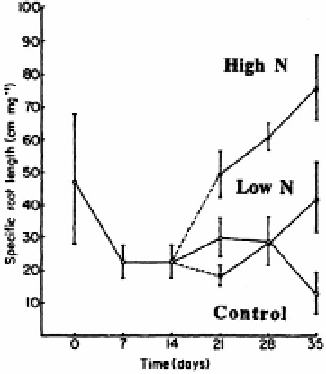Agriculture Reference
In-Depth Information
whereas on the plateau, they grow down to the bedrock, at a depth of 130 cm. In soils
restored after open-cast mining, Fairley (1985) showed that drainage tends to reduce the
root biomass and specific root length in Perennial Ryegrass (
Lolium perenne
).
Conversely, roots may also extend deep into the soil to seek water from the water table
or moister deep soil horizons. As an example, (Seguin, 1970) showed that the deeper
roots of the grape plants were concentrated at 60-120 cm and that maximum water
extraction occurred at that depth (Figure III.14). In the Australian dry tropics, the roots
of
Ficus
spp. growing on karst landscapes have been observed to extend many metres under-
ground through faults and caves to reach the water table (Clarke, 1968 in Bowen, 1984).
Soil horizontal variability
The distributions of absorbing roots and their associated mycorrhizae are greatly affected
by the horizontal distributions of soil resources. St. John
et al.
(1983) have shown that
tree roots in the Amazonian forest grow at random but, when a nutrient-rich site is
encountered, branching is increased and favours a more intensive exploitation of the site.
Similar results have been found by Robinson and Rorison (1983) in 'split-root' experi-
ments. In such experiments, parts of the root systems supplied with high levels of
nitrogen show large increases in specific root length. The other part of the root system
may also show a similar response, but with a significant time-lag (Figure III.22). Such a
growth pattern may explain the negative binomial distribution of roots and their
associated mycorrhizae observed in this forest.


